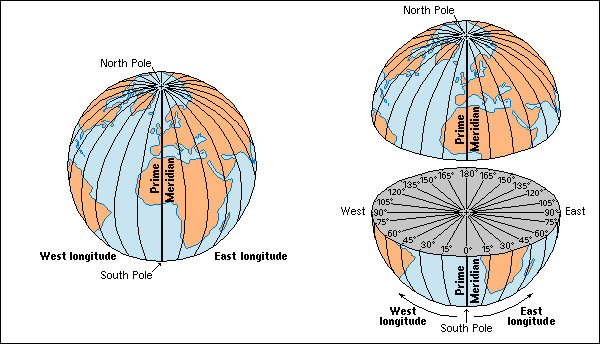Longitude. If one person on the equator travels directly north, and another person 69 miles (111 kilometers) west also travels directly north, their paths will meet at the North Pole. Each person will have traveled in the same direction along a different line of longitude. Lines of longitude run north and south along the surface of the earth. Mapmakers think of the earth as a huge globe that is divided into 360 equal slices. The lines between the slices on the outside of the globe are called meridians. Meridians are the main lines of longitude on maps.

Longitude and location.
Most nations start counting longitude east and west from an imaginary line running through Greenwich, a borough of London. These countries have agreed Greenwich lies at 0° longitude.
The earth is divided into two parts, or hemispheres, of east and west longitude. Each hemisphere has 180 degrees. Degrees of longitude are used to measure east and west distances on maps. They are used, along with degrees of latitude, to find certain points (see Latitude ). For example, New York City lies at 74° west longitude. This means that if a person travels west from Greenwich to New York City and counts the imaginary meridians, New York City would lie on the 74th meridian west of Greenwich. Sailors and pilots use longitude to help determine the location of their ships and airplanes.
The space between two meridians is greatest at the equator–about 69 miles (111 kilometers). This space narrows as the meridians approach the North and South poles. For example, a degree of longitude at New Orleans is about 60 miles (97 kilometers) wide. At Winnipeg, Canada, which lies much nearer the North Pole, a degree of longitude is less than 45 miles (72 kilometers) wide. At Fairbanks, Alaska, which is still closer to the pole, it is even narrower.
Longitude and time.
Any point on the earth’s surface traces a whole circle–360 degrees–once every 24 hours. It does this because the earth turns once on its axis every 24 hours. All 360 degrees of the earth’s circumference also pass beneath the sun once in 24 hours. In one hour, 1/24 of 360 degrees, or 15 degrees, passes beneath the sun. Because it seems that the sun is moving instead of the earth, people say that one hour of time equals 15 degrees of longitude.
Each degree of longitude is divided into 60 parts called minutes. Each minute is divided into 60 seconds of longitude. These minutes and seconds of longitude measure distance, not time. But since an hour of time equals 15° of longitude, a minute or second of time equals a certain distance that can be expressed in minutes and seconds of longitude.
The following table gives the equivalent in distance for five units of time. These units range from a day to a second:
24 hours of time = 360° of longitude 1 hour of time = 15° of longitude 4 minutes of time = 1° of longitude 1 minute of time = 15 minutes of longitude 1 second of time = 15 seconds of longitude
